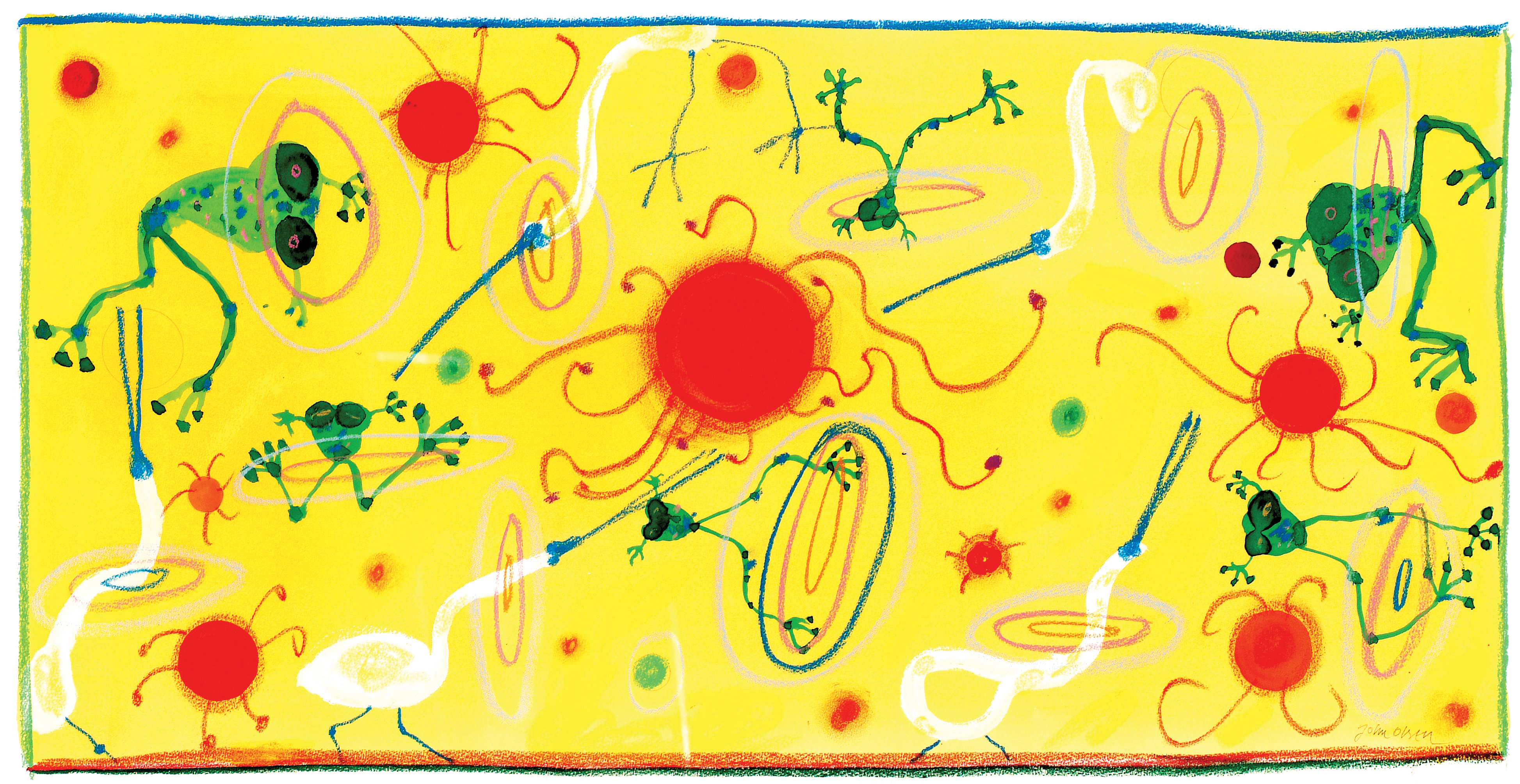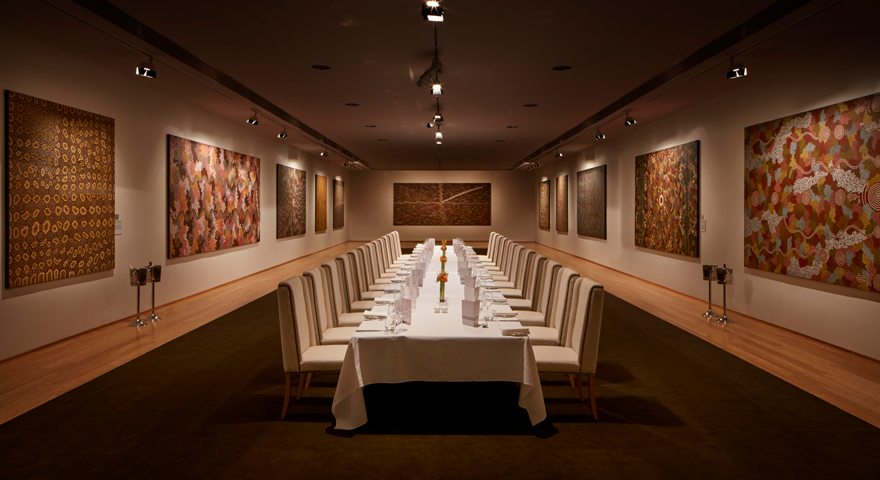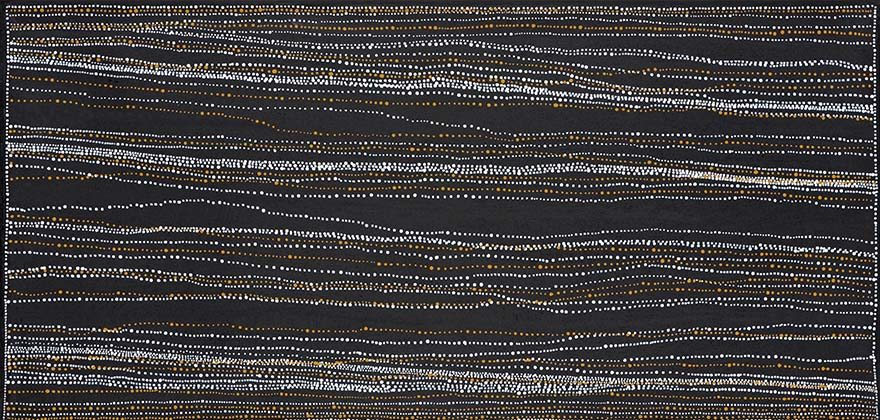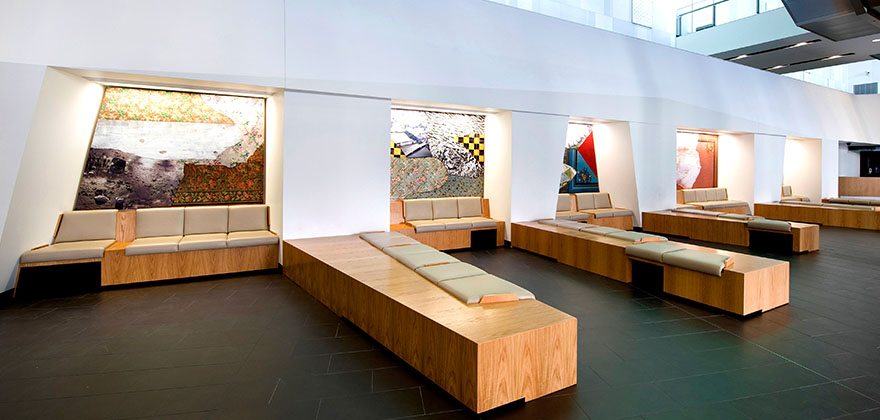The BCEC Art Collection
Since opening in 1995, the Brisbane Convention & Exhibition Centre has showcased the talent of Australia’s leading Indigenous and non-Indigenous contemporary artists. Comprising more than 50 works including paintings, works on paper, sculptures and site-specific installations, the BCEC Art Collection tells the dynamic and diverse story of visual arts practice in Australia from the 1980s through to today.
The origins of the BCEC Art Collection can be traced back to twenty-seven paintings by Aboriginal artists, from the Papunya Tula arts centre in the Northern Territory, commissioned for display as part of Expo ’88 in Brisbane. Papunya Tula was the birthplace of the contemporary Aboriginal art movement in the late 1970s, when teacher Geoffrey Bardon introduced artists to acrylic paint allowing them to translate their traditional designs and stories onto canvas.
The paintings were displayed in the Expo Authority’s own pavilion to widespread acclaim. At the conclusion of Expo, the paintings became the property of the South Bank Corporation and were placed in storage until 1994, when they were conserved and re-stretched for the opening of the Brisbane Convention & Exhibition Centre, located on the former Expo site. These paintings form the core of the BCEC Art Collection and can be viewed in the dedicated Indigenous Gallery and other locations on the Plaza Level of the Centre.
Showcased alongside these works are paintings, sculptures and works on paper by many of Australia’s leading contemporary artists, acquired for the BCEC from leading commercial galleries and artists prior to its opening in 1995. Of particular note is Queensland Lily Pond 1994 a watercolour by senior Australian artist John Olsen. This work was transposed by the artist to create the 750 square metre terrazzo floor that visitors encounter as they arrive at the Centre’s main entry. The terrazzo was the first of several site-specific artworks commissioned especially for the Centre.
Also located in the Centre’s main foyer, Upstream 2001 is a wall-based work comprising river stones and stainless steel cables by Queensland public artist Jodie Cox.
Sandhills 2008 an acrylic on canvas by the celebrated Dorothy Napangardi was acquired for the BCEC Art Collection in 2012 and subsequently transposed (in collaboration with the artist) for the design of the Centre’s stunning Plaza Ballroom’s carpet.
In 2012, the Centre undertook a major expansion project, increasing its footprint and providing access to Grey Street. As part of this development, Brisbane based artist Bruce Reynolds was commissioned to create Pamphlet 2010–12 a multi-part, site specific installation that references local history and welcomes visitors to the Centre’s Grey Street entrance.
The BCEC is delighted to make its Art Collection accessible to visitors and members of the public, as part of its long-term commitment to showcasing and supporting contemporary Indigenous and non-Indigenous Australian art.
PLEASE NOTE: A number of artworks are currently offsite for conservation purposes.

‘Queensland Lily Pond’ – By John Olsen
The spectacular images and bold colours of one of Australia’s most significant and accomplished artists, John Olsen, have been adapted onto the terrazzo floor of the Centre’s foyer from his painting ‘Queensland Lily Pond’.
The Olsen work, in its predominant position in the Centre’s main entrance, has become acknowledged as an integral component of the Centre’s signature and an appropriate recognition of the Centre’s collection of important works.
Plaza Gallery
The Centre takes pride in furthering and promoting interest in Australian Indigenous art and from its earliest days has built one of the most significant collections of Central Desert Art. This museum quality collection of Indigenous art is currently on display in the Centre’s permanent art space – the Plaza Gallery.


Plaza Ballroom
Brisbane Convention & Exhibition Centre’s signature gala event space – the Plaza Ballroom – home to the majority of Brisbane’s premier gala and celebrity events, now proudly showcases what is perhaps the largest artwork on display in Australia. A painting by the highly regarded Aboriginal artist, Dorothy Napangardi, has been reproduced on to the Ballroom’s new carpet to great effect.
Grey Street
Brisbane artist Bruce Reynolds was commissioned to create a site-specific installation for the Brisbane Convention & Exhibition Centre’s Grey Street expansion in 2010. Reynolds creates pictorial objects from linoleum, paint and photography, as well as architecturally integrated relief work in plaster and polyurethane foam. Through the use of such materials, he pursues his interest in the relationship between pattern, history and the built environment.

ART OF CENTRAL AUSTRALIA
The paintings in this gallery were originally commissioned for display at the 1988 World Expo in Brisbane. They represent a style of Aboriginal painting that emerged from one of the most remarkable developments in 20th century art. In the early 1970s, 250 kilometres west of Alice Springs at the Aboriginal settlement of Papunya, artists began to paint their traditional designs using modern art materials.
Over 20 artists were in this first group of Papunya painters, nearly half of whom are represented in the Brisbane Convention & Exhibition Centre Indigenous Art Collection. The collection includes paintings by Kaapa Tjampitjinpa, Clifford Possum Tjapaltjarri and Johnny Warangula Tjupurrula, who are now seen as key figures in the history of Australian art. The art of the Australian desert is now recognised and collected all over the world.
The subjects of the paintings are closely associated with the identity of the painter. Artists often say they are painting ‘my story’, meaning that they are depicting events, places, animals or plants with which they believe their identity to be strongly connected. In the English language the word ‘dreaming’ is often used to refer to these stories. The term reflects Aboriginal belief that the past is eternally present.
Many of the symbols used in desert art are described as secret-sacred because they have a religious significance that restricts their display. To prevent them from being seen by people who have not been initiated into ceremonial practice, some details are excluded from paintings or are camouflaged by a background pattern of dots. As a result, non-Aboriginal observers often refer to this style of desert art as ‘dot-painting’.
The art movement spread rapidly through desert settlements. Art production generates a substantial income for these communities. Within ten years, people who had been removed from their lands to form the settlement at Papunya had earned enough money to found their own community in their own part of the country.
The most prominent Aboriginal and Torres Strait Islander artists are now among the leading figures in Australian art. This has occurred not only in remote communities where people have retained many aspects of their ancient traditional way of life, but also in cities where urban indigenous artists are active participants in contemporary global culture. All these developments can be traced back to the appearance of the style of painting represented in this gallery.
– Timothy Morrell
Timothy Morrell is an independent curator and writer who was formerly Curator of Contemporary Australian Art at the Queensland Art Gallery.
HISTORY OF THE COLLECTION
John Truscott, the Creative Director of the 1988 World Expo in Brisbane, originally proposed the idea of commissioning paintings by Aboriginal artists from the central desert for an Expo display at South Bank. The 27 paintings were assembled in 1987. They were installed as part of the Expo Authority’s own pavilion and were displayed outdoors, under protective sails, in a spiral arrangement devised by Truscott. The collection was called The Art of Central Australia.
The Brisbane art dealer Philip Bacon wrote that this group of paintings was ‘…one of the most acclaimed exhibits at Expo, and received a vast amount of publicity… particularly overseas…The artists represented are considered by the experts to be the greatest of this famous school…The value of this collection lies in its very composition, and in its completeness.’
The paintings became the property of the South Bank Corporation (the reconstituted Expo Authority) after the conclusion of Expo. The possibility of selling the paintings was already being explored soon after they were commissioned. In a letter to New York art dealer John Weber dated 28 March 1988, John Truscott wrote ‘We are not interested in selling the works as individual pieces, but only as a collection in its entirety.’
Philip Bacon Galleries stored the paintings, rolled up, from 1988-1993.
It was finally decided to use the collection in the then new Brisbane Convention & Exhibition Centre.’ In March-April 1995, in preparation for display, the paintings were cleaned, conserved and re-stretched ready for hanging.
View the Collection (PDF) 608KB
Brisbane Convention & Exhibition Centre’s signature gala event space – the Plaza Ballroom – home to the majority of Brisbane’s premier gala and celebrity events, now proudly showcases what is perhaps the largest artwork on display in Australia.
A painting by the highly regarded Aboriginal artist, Dorothy Napangardi, has been reproduced on to the Ballroom’s new carpet to great effect.
The painting, ‘Sandhills’ was purchased by the Convention Centre from the artist with her blessing for the specific purpose of recreating the artwork on carpet, giving thousands of international and national delegates the opportunity to experience the acknowledged spiritual beauty of Central Desert Art.
The Centre’s Director of Operations, Geoff Hanrahan worked with local designer Carly Perkins to create this spectacular example of carpet art which now adorns 2,000 square metres of the ballroom floor.
‘Sandhills’ portrays the journey of ancestral women to the sacred salt site of Mina Mina, in remote Northern Territory, their home and birthplace of the traditional Indigenous digging stick.
The Centre takes pride in furthering and promoting interest in Australian Indigenous art and from its earliest days has built one of the most significant collections of Central Desert Art. This museum quality collection of Indigenous art is currently on display in the Centre’s permanent art space – the Plaza Gallery.
Brisbane artist Bruce Reynolds was commissioned to create a site-specific installation for the Brisbane Convention & Exhibition Centre’s Grey Street expansion in 2010. Reynolds creates pictorial objects from linoleum, paint and photography, as well as architecturally integrated relief work in plaster and polyurethane foam. Through the use of such materials, he pursues his interest in the relationship between pattern, history and the built environment.
Pamphlet is the artist’s largest public art work to date, comprising an external installation of polyhedral forms ‘Fortune’ welcoming visitors to the Centre’s Grey Street entrance; a series of alcove linoleum collages ‘Tea Leaf Paradox’ located in the Grey Street foyer; and hand-carved relief panels ‘Unfolded’ on the feature wall between the Mezzanine and Plaza levels.
The work is named after Thomas Pamphlet, a convict and castaway who was marooned in Moreton Bay and led John Oxley to the Brisbane River. In this ambitious work, Reynolds draws together elements of the early settlement of the Brisbane River, as well as the landscape, industrial history and current usage
of the Centre’s Grey Street site.
‘Tea Leaf Paradox’
Linoleum, Five parts
These five panoramic collages incorporate domestic pattern, colour and landscape imagery that reflect on incidents and narratives of the Brisbane River. The collages refer to small changes and dramatic events that have occurred over the previous two centuries, such as homes and industries being built along the river, the ravages of flood, and the passage of time. These large scale collages invite reflection by linking interior domestic patterns with the landscape and combining intimate and panoramic elements.
‘Unfolded’
High-density polyurethane foam, Sixteen parts
A vocabulary of colourless pattern has been carved directly into these relief panels. The various patterns imply a residual memory and decorative aspect to patterning that exists elsewhere on the site.
‘Fortune’
External installation of polyhedral forms
The outdoor sculptural installation features images of South Bank during the 2011 flood, which inundated the Centre and delayed the opening of its Grey Street expansion until 2012.